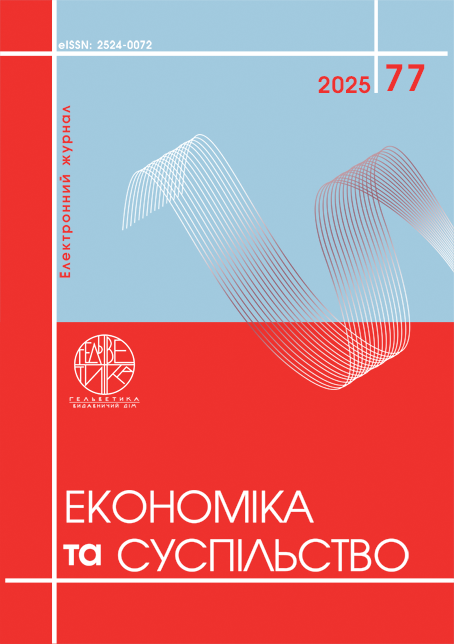APPLICATION OF POWER INDICES BY NATIONAL ECONOMIC ENTITIES FOR ULTIMATE BENEFICIAL OWNER IDENTIFICATION
Abstract
The research explores the possibility of using power indices by primary financial monitoring entities to identify the ultimate beneficial owners of their clients. It outlines the algorithm for calculating the Shapley-Shubik index, the Banzhaf index, and the Deegan-Packel index. It was determined that the Shapley-Shubik index and the Deegan-Packel index are advisable for use when applying enhanced due diligence measures to a client and when a reporting entity calculates its own risk profile. If clients are assigned a low or medium risk level, it is recommended to apply the Banzhaf index, which identifies the degree of a shareholder's power regardless of the order in which the company owner joins a winning coalition. Another advantage of using the Banzhaf index is its indifference to the number of shareholders capable of making a management decision.
References
Stepanenko, N. V., Hurenko V. A. (2023) Osoblyvosti vyznachennya kintsevoho benefitsiarnoho vlasnyka u neprybutkovykh orhanizatsiyakh Ukrayiny [Features of determining the ultimate beneficial owner in non-profit organizations in Ukraine]. Yurydychnyy byuletenʹ – Legal Bulletin, vol. 198(10), pp. 138–145. DOI: https://doi.org/10.31732/2708-339x-2023-10-138-145 (accessed July 28, 2025)
Yamnenko T. M., Savenkova V. G. (2023) Benefitsiarnyy vlasnyk u konteksti diyalʹnosti FATF [Beneficial owner in the context of FATF activities]. Naukovyy visnyk Uzhhorodsʹkoho natsionalʹnoho universytetu. Seriya: Pravo – Uzhhorod National University Herald. Series: Law, vol. 1 (80), pp. 630–633. DOI: https://doi.org/10.24144/2307-3322.2023.80.1.97 (accessed July 28, 2025)
Mitić, I. (2023) UBO Information Transparency in the Corporate Registers and Its Effect on Privacy Protection from AML-CFT Perspective. FACTA UNIVERSITATIS-Law and Politics, vol. 21 (1), pp. 11-25. DOI: https://doi.org/10.22190/fulp230422002m (accessed July 28, 2025)
Jafarnejad S., Robinet F., Frank R. (2024) A Risk-Based AML Framework: Finding Associates Through Ultimate Beneficial Owners. 2024 IEEE Symposium on Computational Intelligence for Financial Engineering and Economics (CIFEr), Hoboken, NJ, USA, 22–23 October 2024, pp. 1–7. DOI: https://doi.org/10.1109/cifer62890.2024.10772816 (accessed July 28, 2025)
Von Haenisch H. J., Egner T. (2024) Know your customer: Unravelling the challenges. Journal of Payments Strategy & Systems, vol. 18 (1), pp. 30–38. DOI: https://doi.org/10.69554/klro4841 (accessed July 28, 2025)
Kaczmarek J., Rothe J. (2024) Control by Adding Players to Change or Maintain the Shapley–Shubik or the Penrose–Banzhaf Power Index in Weighted Voting Games Is Complete for NPPP. Frontiers in Artificial Intelligence and Applications, vol. 392, pp. 3525-3532. DOI: https://doi.org/10.3233/faia240906 (accessed July 28, 2025)
Alon N., Edelman P. H. (2010) The inverse Banzhaf problem. Social Choice and Welfare, vol. 34 (3), pp. 371–377. DOI: https://doi.org/10.1007/s00355-009-0402-8 (accessed July 28, 2025)
Przybyła-Kasperek M., Smyczek F. (2022) Comparison of Shapley-Shubik and Banzhaf-Coleman power indices applied to aggregation of predictions obtained based on dispersed data by k-nearest neighbors classifiers. Procedia Computer Science, vol. 207, pp. 2134–2143. DOI: https://doi.org/10.1016/j.procs.2022.09.273 (accessed July 28, 2025)
Deegan Jr, J., & Packel, E. W. (1978) A new index of power for simple n-person games. International Journal of Game Theory, vol. 7 (2), pp. 113–123. DOI: https://doi.org/10.1007/BF01753239 (accessed July 28, 2025)
Степаненко Н. В., Гуренко В. А. Особливості визначення кінцевого бенефіціарного власника у неприбуткових організаціях України. Legal Bulletin. 2023. № 198 (10). С. 138-145. DOI: https://doi.org/10.31732/2708-339x-2023-10-138-145 (дата звернення: 28.07.2025)
Ямненко, Т. М., Савенкова, В. Г. Бенефіціарний власник у контексті діяльності FATF. Науковий вісник Ужгородського національного університету. Серія: Право. 2023. № 1(80). С. 630-633. DOI: https://doi.org/10.24144/2307-3322.2023.80.1.97 (дата звернення: 28.07.2025)
Mitić, I. UBO Information Transparency in the Corporate Registers and Its Effect on Privacy Protection from AML-CFT Perspective. FACTA UNIVERSITATIS-Law and Politics. 2023. № 21 (1). C. 11-25. DOI: https://doi.org/10.22190/fulp230422002m (дата звернення: 28.07.2025)
Jafarnejad S., Robinet F., Frank R. A Risk-Based AML Framework: Finding Associates Through Ultimate Beneficial Owners. 2024 IEEE Symposium on Computational Intelligence for Financial Engineering and Economics (CIFEr), Hoboken, NJ, USA, 22–23 October 2024. 2024. C. 1–7. DOI: https://doi.org/10.1109/cifer62890.2024.10772816 (дата звернення: 28.07.2025)
Von Haenisch H. J., Egner T. Know your customer: Unravelling the challenges. Journal of Payments Strategy & Systems. 2024. № 18 (1). C. 30–38. DOI: https://doi.org/10.69554/klro4841 (дата звернення: 28.07.2025)
Kaczmarek J., Rothe J. Control by Adding Players to Change or Maintain the Shapley–Shubik or the Penrose–Banzhaf Power Index in Weighted Voting Games Is Complete for NPPP. Frontiers in Artificial Intelligence and Applications. 2024. № 392. C. 3525-3532. DOI: https://doi.org/10.3233/faia240906 (дата звернення: 28.07.2025)
Alon N., Edelman P. H. The inverse Banzhaf problem. Social Choice and Welfare. 2010. № 34 (3). С. 371–377. DOI: https://doi.org/10.1007/s00355-009-0402-8 (дата звернення: 28.07.2025)
Przybyła-Kasperek M., Smyczek F. Comparison of Shapley-Shubik and Banzhaf-Coleman power indices applied to aggregation of predictions obtained based on dispersed data by k-nearest neighbors classifiers. Procedia Computer Science. 2022. № 207. C. 2134–2143. DOI: https://doi.org/10.1016/j.procs.2022.09.273 (дата звернення: 28.07.2025)
Deegan Jr, J., & Packel, E. W. A new index of power for simple n-person games. International Journal of Game Theory. 1978. № 7 (2). C. 113–123. DOI: https://doi.org/10.1007/BF01753239 (дата звернення: 28.07.2025)
Copyright (c) 2025 Володимир Вареник

This work is licensed under a Creative Commons Attribution 4.0 International License.


